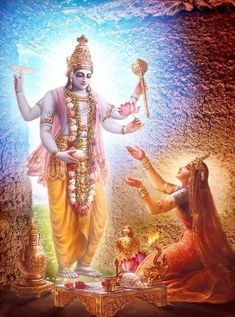
Prabodhini Ekadashi
The month of ‘Kartik’ in Hindu calendar is considered as the most sacred and auspicious month. It is full of festivals, religious activities and rituals. Prabodhini Ekadashi is one of them. It falls on the 11 th lunar day of Kartik month (Oct-Nov) during Shukla Paksh. It is dedicated and celebrated as an expression of reverence to Lord Vishnu.
The festival is also called Dev Utthani Ekadashi. ‘Dev Utthani’ means to wake up God and ‘Ekadashi’ means the 11 th day. Prabodhini also means awakening. Hence this particular day is the day when some specific rituals are performed to wake up Lord Vishnu, the ‘Palak’ (one who takes care of the well being of all the people on earth, the nurturer). It is believed that on this day Lord Vishnu gets up from his sleep after four months.
The story
The story of Lord Vishnu’s sleeping and awakening goes like this— in the trinity (Brahma, Vishnu and Shiva) the onus of looking after the entire creation is up to Vishnu. Once He got so busy in fighting with the evil and restoring peace and order that He could not sleep for years, and then fell asleep for a long time. Perturbed by His disrupted schedule His consort Devi Lakshmi requested Him to regularise it so that She too could get proper rest. Realizing the misery of His wife Lord Vishnu decided to sleep for four months in a year regularly. Hence, He goes to sleep on ‘Dev Shayani Ekadashi’ in the month of Ashadh (June-July) and wakes up on ‘Prabodhini Ekadashi’.
Significance
Dev Utthani Ekadashi is very important for most of the people as it marks the beginning of the marriage season and other important ceremonies or projects. People wait eagerly for this day so that they can conduct marriage and other auspicious ceremonies. The four months period (chaturmas) from Dev Shayani Ekadashi to Prabodhani Ekadashi is considered inauspicious for such sacred functions as Lord Vishnu is asleep at that time.
Rituals and Tulsi Vivah
On this auspicious day devotees take an early morning bath and observe fast. Devotees also throng to holy rivers of Ganga and Yamuna to take sacred bath on this pious day to sanctify themselves.
Tulsi is the most common but holy plant in every Hindu household. According to Hindu scriptures, a woman named ‘Vrinda’ who was an ardent devotee of Lord Vishnu wanted to be His wife. The lord granted that she will be united with Him in the form of the Tulsi plant. On Prabodhini Ekadashi devotees perform Tulsi’s marriage with Vishnu in the form of Shaligram (black stone from Gandaki River worshipped as Vishnu). This ritual is performed as a good omen for the beginning of marriage season. The sacred plant of Tulsi is adorned like a bride with red cloth and flowers; coloured rangoli is made around Tulsi’s pot. Floor designs are prepared using geru paste and rice paste and images of Lord Vishnu and Lakshmi are prepared from it. Vishnu and Lakshmi pujan is performed with sugarcanes, rice and some seasonal fruits and vegetables. A ‘mandap’ is made around Shaligram and Tulsi using sugarcanes; one of the sugarcane is broken and hung off the roof till Holi when these are burnt at Holika Dahan. If one does not have Tulsi at home, planting it on this particular day is considered auspicious and that brings prosperity and good health.
This Ekadashi also marks the beginning of sugarcane harvest, so Ekadashi puja is performed by farmers. The day is celebrated with different rituals in states of U P, Rajasthan, Gujrat, Bihar, Maharashtra and some southern states.
Author Ms Hema Trivedi is an ardent devotee of SriKrishna.